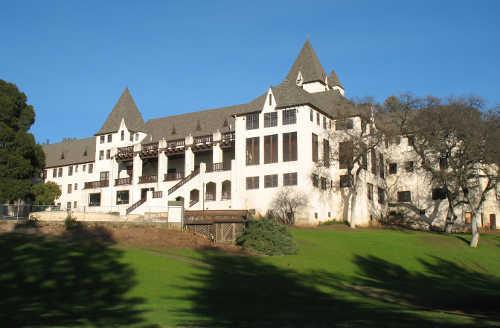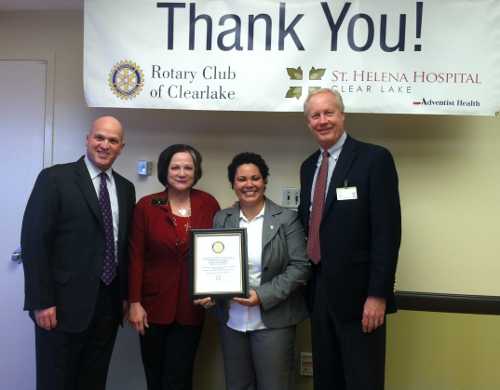- Elizabeth Larson
- Posted On
Redevelopment successor agency oversight board votes to transfer properties to county

LAKEPORT, Calif. – In its first meeting, the newly formed board tasked with overseeing the phaseout of the Lake County Redevelopment Agency voted to transfer several agency-held properties to the ownership of the county, which helped fund many of the purposes either all or in part.
The oversight board for the successor agency to the former Lake County Redevelopment Agency met Monday morning at the Lake County Courthouse in Lakeport and decided to transfer the properties, including the Lucerne Hotel, Holiday Harbor in Nice and Clarks Island in Clearlake Oaks.
The state Department of Finance now has three days to review the decisions before they can become final. County staff intended to notify the agency of the actions on Monday afternoon.
Oversight board members include Eric Seely, the redevelopment agency’s deputy director; Supervisor Denise Rushing, who was elected the board chair; Lake County Superintendent of Schools Wally Holbrook, elected the board’s vice chair; Michelle Buell, director of business services for the Lake County Office of Education; Holly Harris, member of the public; and Jay Beristianos, Northshore Fire Protection District chief. Kathy Lehner, president/superintendent of Mendocino College, also is a member but was unable to attend.
Also at the meeting were County Administrative Officer Kelly Cox and members of his staff, including Debra Sommerfield, Matt Perry, Jeff Rein, Kathy Barnwell and Alan Flora; County Counsel Anita Grant and one of her deputies, Lloyd Guintivano; and County Clerk/Auditor-Controller Cathy Saderlund.
Cox told the group that the county took “the high road” and didn’t move properties and funds around in an effort to shield them from the redevelopment phaseout, which he expects will save the board some work in having to make the kinds of reversals other oversight boards may face.
He said the county is fully prepared to comply both with the spirit and the letter of the law to end redevelopment, noting it’s in the county’s best interest to make sure the dissolution is done quickly and properly.
Perry said the state is ordering redevelopment agencies to be dissolved “expeditiously” and in a manner that maximizes the value of properties.
Properties acquired through the use of tax increment revenue – the increase in property tax valuation seen in redevelopment areas – are to be sold, according to the new guidelines, he said.
In the absence of redevelopment, the county and other taxing agencies will see an increase in the tax revenues they receive, according to county staff.
Current projections are for the county general fund to receive $563,253 annually; $37,202 for the county roads department; $22,834 to the county’s library system; $189,394 to Northshore Fire Protection District; and $708,984 to schools in the redevelopment agency area.
Once it established its leadership, reviewed enforceable obligations, and approved its budget and the use of county administrative staff, the board discussed action to take on the redevelopment agency’s main assets, chief among them the Lucerne Hotel – known as “The Castle” – and Holiday Harbor.
Marymount College is in talks with the county about locating a college campus at The Castle, and is sending a delegation to visit the county later this month, Flora said.
The Castle is considered one of the agency’s most important assets due to the amount of money and effort put into its remodel, he said.
The county loaned the agency $1.35 million to purchase the building from a group of churches in 2010. Administrative office staff said a Sept. 10, 2010, loan agreement between the county and agency makes the funding source an “extremely straightforward” matter.
“The county bought this,” Cox said of the building.
While state legislation involving redevelopment dissolution does not allow the agency to pay back the $5 million it was loaned from the county general fund, Flora said staff believes the county can take The Castle since county funds – and not tax increment revenue – purchased the building.
Cox explained that the county’s ultimate goal – to see the property used for a purpose like a college campus – will benefit all of the taxing entities far more than if it were merely sold.
County staff said Holiday Harbor – purchased to be Nice’s town center – also was purchased with about $1.9 million in county loans.
The group voted separately to transfer the Lucerne Hotel, Holiday Harbor as well as several other assets – parcels for parking at the Lucerne Hotel, beachfront parcels next to Holiday Harbor, Clarks Island in Clearlake Oaks, parcels for the Clearlake Oaks Senior Center, the Lake County Sheriff’s Lucerne substation, Nylander Park in Clearlake Oaks, Harbor Village, Alpine Park and the Third Avenue Plaza and the Lucerne Promenade – to county ownership.
Only the Lucerne Hotel transfer didn’t get a unanimous vote. Beristianos voted against it citing “public safety” issues if the county had to remain responsible for its maintenance.
The board also voted to direct the successor agency to pursue the appropriate method of disposing of paper subdivision lots donated to the agency.
The lots, which cover the hillsides above Nice and Lucerne, were used to help finance the Lucerne Hotel’s construction in the 1920s, Rushing said.
However, in the decades since, the lots – many of which are not suitable for building due to steep terrain, lack of roads and utilities – have been sold and resold, and have become a target of squatting and illegal dumping.
Rushing said she would like to see the county continue to work to get the parcels off the market and use them to create open space.
The board also voted to sell a parcel on Boggs Street and to provide $80,000 to match a grant for a sidewalk project in Clearlake Oaks.
Additionally, the group voted unanimously to terminate an agreement with Rural Communities Housing Development Corp. for a multifamily low-income housing project in Nice.
The county entered into a contract for the project in 2005 and committed $1,248,000 to it, with nearly $627,000 spent, according to county staff.
With the county having no further obligations to build low-income housing as part of redevelopment, the oversight board thought that taking the more than $621,000 that remains and distributing it elsewhere was the better choice.
The board’s meetings and activities will be reported on the county’s Web site at http://www.co.lake.ca.us/Government/Directory/Redevelopment/Successor_Agency/Oversight_Board.htm.
The oversight board will next meet March 5.
E-mail Elizabeth Larson at This email address is being protected from spambots. You need JavaScript enabled to view it. . Follow Lake County News on Twitter at http://twitter.com/LakeCoNews, on Tumblr at www.lakeconews.tumblr.com, on Google+, on Facebook at www.facebook.com/pages/Lake-County-News/143156775604?ref=mf and on YouTube at www.youtube.com/user/LakeCoNews .

 How to resolve AdBlock issue?
How to resolve AdBlock issue? 






























